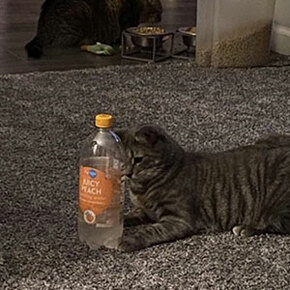
20 Fascinating Facts About The World You Might Not Have Known, From This Insta Page
Just like our tummies love a little bite-sized snack so do our brains. And we can’t help but voraciously absorb little tidbits of knowledge just to keep us entertained. If your brain has the munchies, the Ask Me Knowledge Insta page shares some of the best little-known fun facts that might even seem unbelievable at times. If you love a little ‘snacking’, go ahead and dig in.
#1

Image source: askmeknowledge
#2

Image source: askmeknowledge
The medal was later sold in 2013 at auction for £1,100. The 1941 Blue Cross medal was found in a property clearance in Bristol along with a painting of Great Dane Juliana. A plaque on it describes how the dog put out an incendiary bomb dropped by the Luftwaffe on her owner’s home. Mr Taubenheim, of Wotton Auction Rooms, in Wotton-under-Edge, Gloucestershire, said it was a “remarkable story”. He said the medal had been found at a property which had belonged to a relative of Juliana’s owner.
#3

Image source: askmeknowledge
The marathon CPR went on for 96 minutes. First responders shocked Snitzer’s heart 12 times, and they administered intravenous dru_gs. When they finally had a pulse and a regular heart beat a, Snitzer was airlifted to the Mayo Clinic. After 10 days, he was released from the hospital — miraculously healthy, and incredibly grateful. “My heart wasn’t pumping anything, so the only thing that was pumping my blood was those guys doing CPR,” he said. “I think it’s the quality of the person,” he said. “We’re in small-town America, hard-working people. I happened to have a king-size heart attack in the right place and the right time, and these guys would not give up.” He came to thank his neighbors — no longer strangers. People who simply would not quit when he needed them most. “I feel like I have a responsibility to them to live the best life possible and honor the effort they made,” Snitzer said. ~ As per reports.
#4

Image source: askmeknowledge
#5

Image source: askmeknowledge
Typical ending in many tales is ‘Bad criminal/animal was punished by local government official. {And men and women lived happily}/{Ghost with grudge never came because her grudge was vanished.}’….The Korean mode of storytelling began with either “Once upon a time back when tigers used to smoke,” “Once upon a time when tigers smoked pipes,” “A long, time ago when tigers were smoking,” or “Once upon a time when tigers were smoking.”
.
That intro to a story does sound odd to those of us who are used to “Once upon a time. “A long time ago, before the 17th century, tobacco was touted as a medicinal product in Korea, and smoking tobacco was something most could afford to do. Alas, in the 17th century, tobacco became a luxury item, and only aristocrats were allowed to smoke tobacco. Peasants used to watch the well-to-do enjoy their smoking of tobacco, and the peasants would lament, “We miss the days when even the tigers were smoking.” Back when tigers used to smoke,” would not be acceptable these days.
#6

Image source: askmeknowledge
Due to the common association of the label with cheap, low-quality, and often dangerous products, the phrase “Made in China” is often used in a pejorative manner to refer to any low-quality products regardless of origin
#7

Image source: askmeknowledge
The 1988 movie comedy A Fish Called Wanda features a scene where actor Michael Palin gets some French fries stuffed up his nose. A person named Ole Bentzen found the scene so sidesplittingly funny for almost 25 minutes that his heart rate rose to an estimated 250-500 beats per minute, leading to a heart attack as he laughed his way into the afterlife.
#8

Image source: askmeknowledge
She did so to hide any privacy complaints. She had affairs with married men (as per sources) and waited for her husband and others to die before publication of her autobiography.
#9

Image source: askmeknowledge
In 2003, after mentioning this desire in an interview, a friend of his who owns a mall with a supermarket closed it all down for a day to grant him his wish. To give it a feeling of authenticity, Michael’s staff, family, and friends populated the grocery store. Some dressed up like the store’s staff, others like shoppers. Even the muzak was customized for his experience. Then, the King of Pop put on a single yellow latex glove and pushed his cart up and down the aisles. He played around a lot in the store and likened the experience to being at Disneyland, because as he says, “I got to do something I don’t normally get to do.” I’m not sure he got an authentic grocery shopping experience but it is fascinating, if not heartbreaking, to watch him try.
#10

Image source: askmeknowledge
#11

Image source: askmeknowledge
Inmates in federal prisons holding some of Brazil’s most notorious criminals are able to read up to 12 works of literature, philosophy, science or classics to trim a maximum 48 days off their sentence each year, the government announced. Prisoners will have up to four weeks to read each book and write an essay which must “make correct use of paragraphs, be free of corrections, use margins and legible joined-up writing,” said the notice published on Monday in the official gazette. A special panel will decide which inmates are eligible to participate in the program dubbed “Redemption through Reading”. “A person can leave prison more enlightened and with an enlarged vision of the world,” said a lawyer, who heads a book donation project for prisons.
#12

Image source: askmeknowledge
The young owls resting on a tree branch don’t fall off, thanks to the strength of their back toe called the hallux. The hallux tethers the creature to the branch and it won’t move until the owlet bends its leg. Adult owls are able to support the weight of their heads as they gain strength after a few months. But younger owls struggle to do so and have to lie down while napping.
#13

Image source: askmeknowledge
#14

Image source: askmeknowledge
John McCue first became inspired to patch up some of the road hazards in Stellarton, Nova Scotia after he and his mother drove over a particularly nasty pothole. “There was one story a couple of weeks ago where a car was driving through and it nailed one of the biggest potholes here and it ripped the axle right off the car,” McCue told CBC. Rather than waiting for the city government to fix the pavement, McCue grabbed a snow shovel and started shifting gravel and road fill from the roadside ditches and moving it into the potholes. Now that passing traffic has packed the filling into the holes, McCue said that the road is significantly better than when he started. That being said, local police officers had warned McCue that if he did not stop his mission, then he would be charged.
#15

Image source: askmeknowledge
The adaptation of several anatomical and biochemical mechanisms to establish an immune privileged microenvironment within the eye makes the eye immunologically unique. It is a tissue site where we may learn how immunity is regulated in inflammation and at rest. Certain sites of the mammalian body have immune privilege, meaning they are able to tolerate the introduction of antigens without eliciting an inflammatory immune response. Tissue grafts are normally recognised as foreign antigen by the body and attacked by the immune system. On such problem is autoimmune retinopathy, which is “usually manifested as a vascular problem” . This means that the immune system attacks and inflames the blood vessels in the back of the eye, on the retina, which can affect vision.
#16

Image source: askmeknowledge
After running late to class, George Dantzig copied down two problems he thought were homework and solved them. Those two problems were in fact two famous unsolved problems of statistics, which later earned him his doctorate. One day In 1939, George Bernard Dantzig, a doctoral candidate at the University of California, Berkeley, arrived late for a graduate-level statistics class and found two problems written on the board. Not knowing they were examples of “unsolved” statistics problems, he mistook them for part of a homework assignment, jotted them down, and solved them. (The equations Dantzig tackled are more accurately described not as unsolvable problems, but rather as unproven statistical theorems for which he worked out proofs.) Six weeks later, Dantzig’s statistic professor notified him that he had prepared one of his two “homework” proofs for publication, and Dantzig was given co-author credit on another paper several years later when another mathematician independently worked out the same solution to the second problem.
#17

Image source: askmeknowledge
In modern fairy tales, wolves are often depicted as cunning animals and described as evil animals. But they are not just the most loyal animal in the world but one of the most loyal animals to humans. In fact, they have a family life that may be more than human relations. In general, a group of wolves will contain a male wolf, a female wolf, their children, and be repeated, which is very similar to the family in humans. This makes wolves loyal animals and one of the most faithful animals not just to their partner but to their group and family.
#18

Image source: askmeknowledge
“Where the Wild Things Are” is a classic in the world of children’s picture books, with the titular “things” becoming beloved (if at times scary) storybook characters. But those characters weren’t originally going to be so-called “things.” In another funny twist that Sendak acknowledged was somewhat rude, the things in the story were based on his relatives. While sitting shiva (a Jewish tradition of mourning), Sendak and his siblings saw many of their aunts, uncles and cousins, who inspired the monster-like characters. “I remember our relatives used to come from the old country, those few who got in before the gate closed, all on my mother’s side. And how we detested them,” Sendak told Moyers. “The cruelty that children … you know, kids are hard. And these people didn’t speak English. And they were unkempt. Their teeth were horrifying … hair unraveling out of their noses. And they’d pick you up, hug you and kiss you [and say], ‘Aggghh. Oh, we could eat you up.’” Sendak included the phrase, “We’ll eat you up, we love you so,” in his book, which was first published in 1963 and inspired a movie version released in 2009, as a nod to his family, whom he learned to appreciate in his later years. “And when I remember [my relatives], the discussion with my brother and sister, how we laughed about these people who we of course grew up to love very much, I decided to render them as the wild things, my aunts and my uncles and my cousins,” he said. “And that’s who they are.”
#19

Image source: askmeknowledge
It is located in a park in front of the Institute of Cytology and Genetics of the Russian Academy of Sciences, and was completed on July 1, 2013, coinciding with the 120th anniversary of the founding of the city. The monument commemorates the sacrifice of the mice in genetic research used to understand biological and physiological mechanisms for developing new drugs and curing of diseases. The monument, which sits on a granite pedestal, is of a laboratory mouse wearing pince-nez on the tip of its nose. The mouse holds knitting needles in its paws and is shown knitting a double helix of DNA. The bronze figure is itself only 70 cm (27½”) high, but the total height of the monument including the pedestal is 2.5 meters (98″). The DNA spiral emerging from the knitting needles winds to the left, thus showing that it is the still poorly understood Z-DNA – this symbolic of scientific research that is still to be done. In contrast, the more common B-DNA (depicted in school lessons) winds to the right.
#20

Image source: askmeknowledge
Back in 2011, Roman Ostriakov, a homeless man from Ukraine living in Genova, was convicted for theft after he stole cheese and sausages amounting to €4 from a supermarket. A customer had seen Ostriakov put two pieces of cheese and a packet of sausages in his pocket and only pay for breadsticks at the cashier. He was subsequently sentenced to six months in jail and a €100 fine in 2015. The case went through three rulings in court before it was rejected in May 2016 in a historic ruling citing that the ‘right to survival prevails over property.’ It cited the importance of maintaining a shared humanity and that no one should be allowed to starve in a civilized society.


















Got wisdom to pour?